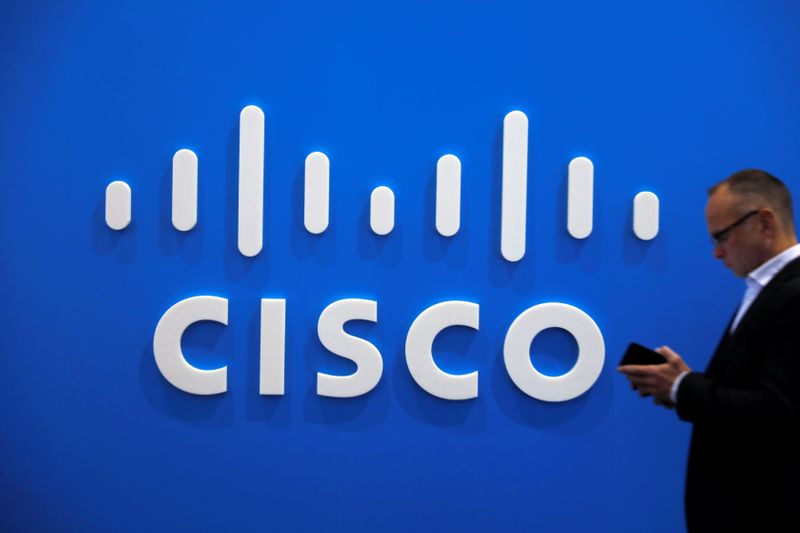Benzinga - by Benzinga Insights, Benzinga Staff Writer.
In the fast-paced and cutthroat world of business, conducting thorough company analysis is essential for investors and industry experts. In this article, we will undertake a comprehensive industry comparison, evaluating Cisco Systems (NASDAQ:CSCO) in comparison to its major competitors within the Communications Equipment industry. By analyzing crucial financial metrics, market position, and growth potential, our objective is to provide valuable insights for investors and offer a deeper understanding of company's performance in the industry.
Cisco Systems Background Cisco Systems is the largest provider of networking equipment in the world and one of the largest software companies in the world. Its largest businesses are selling networking hardware and software (where it has leading market shares) and cybersecurity software like firewalls. It also has collaboration products, like its Webex suite, and observability tools. It primarily outsources its manufacturing to third parties and has a large sales and marketing staff—25,000 strong across 90 countries. Overall, Cisco employees 80,000 employees and sells its products globally.
| Cisco Systems Inc | 15.53 | 4.05 | 3.38 | 4.1% | $3.45 | $8.27 | -12.83% |
| Motorola Solutions Inc | 47.42 | 122.80 | 6.42 | -6.27% | $0.05 | $1.19 | 10.04% |
| Nokia Oyj | 22.92 | 0.90 | 0.91 | 2.08% | $0.66 | $2.23 | -20.34% |
| Juniper Networks Inc | 51.69 | 2.58 | 2.16 | -0.02% | $0.04 | $0.68 | -16.25% |
| F5 Inc | 20.35 | 3.39 | 3.64 | 4.11% | $0.17 | $0.54 | -3.1% |
| Ubiquiti Inc | 25.06 | 338.45 | 4.58 | 1503.1% | $0.12 | $0.17 | 7.69% |
| Ciena Corp | 44.79 | 2.32 | 1.66 | -0.58% | $0.04 | $0.39 | -19.58% |
| Calix Inc | 124.12 | 3.08 | 2.37 | 0.01% | $0.0 | $0.12 | -9.48% |
| Harmonic Inc | 18.18 | 3.16 | 2.25 | -1.91% | $-0.01 | $0.06 | -22.57% |
| Digi International Inc | 58.53 | 1.47 | 1.87 | 0.73% | $0.02 | $0.06 | -3.1% |
| Aviat Networks Inc | 26.23 | 1.43 | 0.93 | 1.33% | $0.01 | $0.04 | 33.7% |
| Average | 43.93 | 47.96 | 2.68 | 150.26% | $0.11 | $0.55 | -4.3% |
th, td { padding: 8px; text-align: left; }
th { background-color: #293a5a; color: #fff; text-align: left; }
tr:nth-child(even) { background-color: #f2f4f8; }
tr:hover { background-color: #e1e4ea; }
td:nth-child(3), td:nth-child(5) { text-align: left; }
.dividend-amount { font-weight: bold; color: #0d6efd; }
.dividend-frequency { font-size: 12px; color: #6c757d; } Upon a comprehensive analysis of Cisco Systems, the following trends can be discerned:
- The Price to Earnings ratio of 15.53 is 0.35x lower than the industry average, indicating potential undervaluation for the stock.
- With a Price to Book ratio of 4.05, significantly falling below the industry average by 0.08x, it suggests undervaluation and the possibility of untapped growth prospects.
- The stock's relatively high Price to Sales ratio of 3.38, surpassing the industry average by 1.26x, may indicate an aspect of overvaluation in terms of sales performance.
- The Return on Equity (ROE) of 4.1% is 146.16% below the industry average, suggesting potential inefficiency in utilizing equity to generate profits.
- The company exhibits higher Earnings Before Interest, Taxes, Depreciation, and Amortization (EBITDA) of $3.45 Billion, which is 31.36x above the industry average, implying stronger profitability and robust cash flow generation.
- The gross profit of $8.27 Billion is 15.04x above that of its industry, highlighting stronger profitability and higher earnings from its core operations.
-
The company's revenue growth of -12.83% is significantly below the industry average of -4.3%. This suggests a potential struggle in generating increased sales volume.
The debt-to-equity (D/E) ratio is a financial metric that helps determine the level of financial risk associated with a company's capital structure.
Considering the debt-to-equity ratio in industry comparisons allows for a concise evaluation of a company's financial health and risk profile, aiding in informed decision-making.
By analyzing Cisco Systems in relation to its top 4 peers based on the Debt-to-Equity ratio, the following insights can be derived:
- In the context of the debt-to-equity ratio, Cisco Systems holds a middle position among its top 4 peers.
- This indicates a moderate level of debt relative to its equity with a debt-to-equity ratio of 0.7, which implies a relatively balanced financial structure with a reasonable debt-equity mix.
This article was generated by Benzinga's automated content engine and reviewed by an editor.
© 2024 Benzinga.com. Benzinga does not provide investment advice. All rights reserved.
